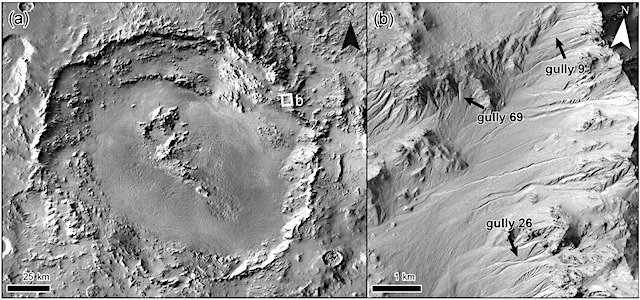 [Editor’s note: From a paper by Tjalling de Haas and six co-authors recently published in the Journal of Geophysical Research.]
[Editor’s note: From a paper by Tjalling de Haas and six co-authors recently published in the Journal of Geophysical Research.]
Initiation and Flow Conditions of Contemporary Flows in Martian Gullies
• We use RAMMS to back calculate initial and flow conditions of recent flows in three gullies in Hale crater
• Recent flows in gullies are fluidized to a similar degree as are wet granular debris flows on Earth
• Very small volumetric fractions of CO2 of ≪1% may yield sufficiently large gas fluxes to fluidize contemporary flow in Martian gullies
Understanding the initial and flow conditions of contemporary flows in Martian gullies, generally believed to be triggered and fluidized by CO2 sublimation, is crucial for deciphering climate conditions needed to trigger and sustain them.
We employ the RAMMS (RApid Mass Movement Simulation) debris flow and avalanche model to back calculate initial and flow conditions of recent flows in three gullies in Hale crater. We infer minimum release depths of 1.0–1.5 m and initial release volumes of 100–200 m3. Entrainment leads to final flow volumes that are ∼2.5–5.5 times larger than initially released, and entrainment is found necessary to match the observed flow deposits.
Simulated mean cross‐channel flow velocities decrease from 3–4 m/s to ∼1 m/s from release area to flow terminus, while flow depths generally decrease from 0.5–1 to 0.1–0.2 m. The mean cross‐channel erosion depth and deposition thicknesses are ∼0.1–0.3 m. Back‐calculated dry‐Coulomb friction ranges from 0.1 to 0.25 and viscous‐turbulent friction between 100 and 200 m/s2, which are values similar to those of granular debris flows on Earth.
These results suggest that recent flows in gullies are fluidized to a similar degree as are granular debris flows on Earth. Using a novel model for mass flow fluidization by CO2 sublimation we are able to show that under Martian atmospheric conditions very small volumetric fractions of CO2 of ≪1% within mass flows may indeed yield sufficiently large gas fluxes to cause fluidization and enhance flow mobility. [More at link]








